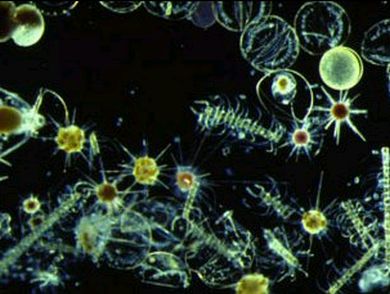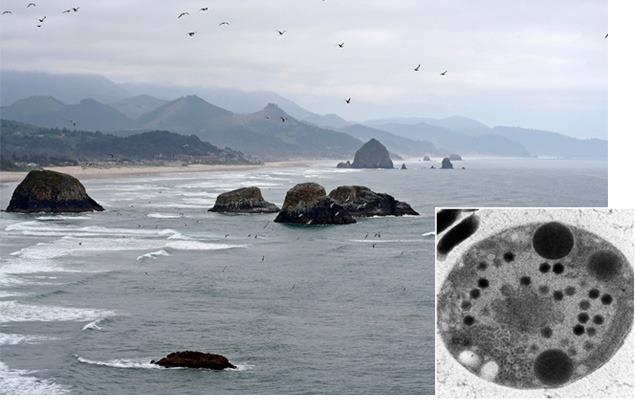TRAFFIC: Carl Zimmer and Penny Chisholm

Welcome back to TRAFFIC, a Chicago Blog series featuring leading figures from across the humanities and sciences, whose prescient views on current events help us to interpret contemporary culture. We’ll be ending a month of Friday TRAFFIC features, led by popular science writer Carl Zimmer, with one final conversation about ocean-borne viruses with Penny Chisholm.
Sallie W. “Penny” Chisholm is the Lee and Geraldine Martin Professor of Environmental Studies and professor of biology at MIT. Her research lab seeks to advance our understanding of the ecology and evolution of microbes in the oceans, and how they influence global biochemical cycles. In January 2010, she was awarded the Alexander Agassiz Medal, for “pioneering studies of the dominant photosynthetic organisms in the sea and for integrating her results into a new understanding of the global ocean.”
Dear Carl,
Thank you for giving viruses the recognition they deserve. As you point out, the discovery of viruses in the oceans is relatively recent. It seems that about once every decade there are similar major discoveries in oceanography that change the way we think about ocean ecosystems. One of these—a discovery by the late John Martin—was that iron availability limits the growth of phytoplankton (your ‘geoengineers’) over large regions of the oceans. This changed the major ‘drivers’ of carbon dioxide absorption by the oceans, and climate models had to be changed accordingly.
Evidence that iron—carried from land to ocean via atmospheric dust—limits the ocean’s capacity to draw carbon dioxide out of the atmosphere has fueled the idea that large scale ocean iron fertilization could be used for engineering Earth’s climate. What does this have to do with viruses (you are wondering)? Well, it turns out that iron has been used to flocculate viruses for wastewater treatment, and to concentrate them from ocean water for scientific study. What if iron dust deposition does the same in the oceans? What if it not only stimulates phytoplankton growth, but also reduces phytoplankton death rates by ‘precipitating viruses’ and settling them out of the system? Might this phenomenon help explain the observed relationships between iron dust deposition and atmospheric carbon dioxide in ice cores? This has been proposed by MIT’s Hyman Hartman, who has also suggested that we might enhance phytoplankton’s capacity to draw carbon dioxide from the atmosphere by (somehow) killing off viruses in the oceans. I doubt he is truly serious. But I also doubted the seriousness, twenty years ago, of people proposing ocean iron fertilization (OIF) as a means of carbon sequestration. Today, research on OIF for geoengineering is endorsed by leading scientists.

Whether or not one takes seriously the idea of global geoengineering with anti-virals, a thought experiment along these lines quickly exposes the complexity of marine microbial systems (give it a try!). In fact, recent field experiments have revealed one of the many possible unexpected consequences; it turns out that when you reduce all the viruses in a sample of seawater you actually decrease the carbon fixation of cyanobacteria, because reduced lysis of heteotrophic bacteria deprives cyanobacteria of essential nutrients they need to grow optimally. In a nutshell, even these simple microbial systems are so complex that it is impossible to predict the consequences of removal of one component.
Just some food for thought.
Penny
Dear Penny:
It is funny how what at first seems absurd when it comes to virus can eventually become conventional wisdom. The very idea that the ocean harbored many viruses was absurd as late as the 1980s. Seawater just seemed like a terrible place for viruses to survive. But when scientists began to give a close look at the ocean, they discovered otherwise. A single spoonful of seawater might harbor a billion viruses. Most of those viruses proved to be bacteriophages—in other words, they infect bacteria. That’s not surprising, because the most abundant hosts in the oceans are microbes. But what is surprising is the effect that those marine phages have on life in the sea. Viruses kill half of all the bacteria in the oceans every day. As you note, the rupturing of all those cells (known as lysis) dumps vast supplies of nutrients into the ocean, possibly fertilizing other microbes to grow faster. Since the microbes of the ocean pull down huge amounts of heat-trapping carbon dioxide from the atmosphere (and also return a lot of it back there), the overall effect that viruses have on the climate could potentially be huge. I can’t help but find the idea of viruses influencing the climate a bit absurd—but the more I learn about viruses in the ocean, the more accustomed I get to it.

Your speculations about viral geoengineering bring a fitting close to the discussions we’ve been having on this blog over the past month. Once scientists discovered viruses, they began to acquire the power to control them. They were able to develop vaccines and public health measures that could sometimes slow their spread. In many cases, we’ve only had moderate success in controlling viruses, but in a few case—such as those of smallpox and rinderpest—we are now at the point where we could soon eradicate entire species of virus from the face of the Earth.
But the discovery of viruses has also revealed to us that they are not merely things that make us sick and must be eradicated. Phages can kill life-threatening bacteria, for example. For now, however, phage therapy is not standard medical procedure, in part because governments are a bit queasy about approving viruses as living drugs. As your MIT colleague Tim Lu explained last week, he’s taking his research in a different direction, using phages to destroy the biofilms that grow in heating and cooling systems in buildings. In effect, he’s trying to heal architecture.
It’s a natural progression from bodies to buildings to the entire planet. At least it’s natural to speculate about using anti-virals to change the global climate. Still, I can’t help but think—what kind of drug store could fill that prescription?
Carl
For more info on A Planet of Viruses, please visit the book’s UCP page here.
This blog and the book A Planet of Viruses are part of the World of Viruses project, funded by the National Center for Research Resources at the National Institutes of Health through the Science Education Partnership Award (SEPA), Grant No. R25 RR024267. Additional materials, including those directed at a K-12 audience, can be found on the World of Viruses website.